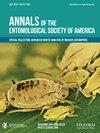Implementing Low-Cost, High Accuracy DNA Barcoding From Single Molecule Sequencing to Screen Larval Tephritid Fruit Flies Intercepted at Ports of Entry
IF 3
3区 农林科学
Q1 ENTOMOLOGY
引用次数: 9
Abstract
Abstract Exotic fruit flies in the family Tephritidae pose a threat to U.S. agriculture and natural resources. As part of ongoing fruit fly detection and exclusion programs, invasive fruit fly adults are periodically trapped in and introduced populations are eradicated from two major fruit producing states: California and Florida. Although the pathways used by flies to enter these states are not clear, one possible introduction pathway is hand-carrying fruits and vegetables infested with eggs or larvae through ports of entry during border crossings or international air travel. These collections represent an important resource for determining what species are most commonly associated with particular ports of entry, their host plants, and source country, making the identification of the intercepted larvae fundamental. Here, we examine cytochrome c oxidase subunit I sequences obtained with Sanger DNA sequencing and Single Molecule Real-time sequencing (SMRT) technologies on a collection of hundreds of intercepted larvae and pupae that are suspected to be fruit pests found in the subfamily Dacinae, in addition to a collection of field-caught flies. Utilizing Pacific Biosciences (PacBio) Circular Consensus Sequencing, we sequenced thousands of independent amplicons in a single SMRT cell. We present our implementation of PacBio's method by describing wet-lab procedures as well as analytical protocols to automate the process. Finally, for the intercepted material, we compared the generated SMRT data to sequences produced with Sanger and evaluate their quality as a means to identify flies. Using intercepted material, we obtained a sequencing success of over 88% with PacBio's SMRT sequencing. As the spread of invasive insects grow, so will the size of collections of intercepted material; we found technologies such as SMRT sequencing to be excellent resources to simplify the generation of large amounts of molecular data and to reduce or eliminate all together the manipulation of the sequences.利用单分子测序实现低成本、高精度DNA条形码筛查入境口岸截获的去甲肾上腺素幼虫
摘要蝇科外来果蝇对美国农业和自然资源构成威胁。作为正在进行的果蝇检测和排除计划的一部分,入侵的成年果蝇定期被困在两个主要的水果生产州:加利福尼亚州和佛罗里达州,并将引入的种群消灭。虽然苍蝇进入这些国家的途径尚不清楚,但一种可能的传入途径是在过境或国际航空旅行期间通过入境口岸携带携带有虫卵或幼虫的水果和蔬菜。这些收集是确定哪些物种与特定入境口岸、寄主植物和来源国最常见的重要资源,使鉴定截获的幼虫成为基础。在这里,我们检测了细胞色素c氧化酶亚基I序列,这些序列是用Sanger DNA测序和单分子实时测序(SMRT)技术获得的,它们收集了数百只被截获的幼虫和蛹,这些幼虫和蛹被怀疑是在Dacinae亚科中发现的水果害虫,此外还收集了一组野外捕获的苍蝇。利用PacBio循环共识测序技术,我们对单个SMRT细胞中的数千个独立扩增子进行了测序。我们通过描述湿实验室程序以及自动化过程的分析协议来介绍PacBio方法的实现。最后,对于截获的材料,我们将生成的SMRT数据与Sanger产生的序列进行比较,并评估其作为鉴定苍蝇的手段的质量。利用截获的材料,我们通过PacBio的SMRT测序获得了超过88%的测序成功率。随着入侵昆虫的传播,截获的材料的收集规模也会增加;我们发现SMRT测序等技术是简化大量分子数据生成和减少或消除所有序列操作的优秀资源。
本文章由计算机程序翻译,如有差异,请以英文原文为准。
求助全文
约1分钟内获得全文
求助全文
来源期刊
CiteScore
4.90
自引率
0.00%
发文量
25
审稿时长
6-12 weeks
期刊介绍:
The Annals of the Entomological Society of America exists to stimulate interdisciplinary dialogue across the entomological disciplines and to advance cooperative interaction among diverse groups of entomologists. It seeks to attract and publish cutting-edge research, reviews, collections of articles on a common topic of broad interest, and discussion of topics with national or international importance. We especially welcome articles covering developing areas of research, controversial issues or debate, and topics of importance to society. Manuscripts that are primarily reports of new species, methodology, pest management, or the biology of single species generally will be referred to other journals of the ESA. The most important criteria for acceptance are quality of work and breadth of interest to the readership.

 求助内容:
求助内容: 应助结果提醒方式:
应助结果提醒方式:


